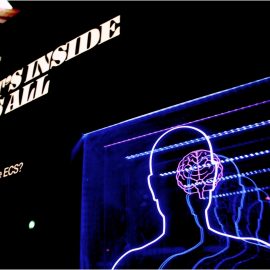

This article is an excerpt from the Shortform book guide to "Awaken the Giant Within" by Tony Robbins. Shortform has the world's best summaries and analyses of books you should be reading.
Like this article? Sign up for a free trial here .
How can Tony Robbins’ NAC technique help you replace negative habits with positive ones? What steps can you take to use Neuro-Associative Conditioning in your own life?
You can use Tony Robbins’ NAC (Neuro-Associative Conditioning) technique to gradually replace negative habits with positive ones. Follow the steps below to disrupt negative emotional patterns in the mind, find motivation, and establish new, empowering behaviors.
Find out more about Tony Robbins’ NAC technique below.
Tony Robbins NAC Technique: Neuro-Associations
How do we come to associate certain things with pain and other things with pleasure? It all starts in your brain: Every time you experience a positive or negative emotion, your brain links the emotion with other aspects of the experience, creating a “neuro-association.”
Your brain’s billions of neurons (brain cells) take in sensory information and work together to process that sensory data. In this process, your neurons communicate by sending signals to each other via neural pathways, which are physical connections in your brain. Those neural pathways create neuro-associations by linking your emotions and sensations from a particular experience. As a result, your future thoughts about that activity or subject automatically trigger the same emotion (unless you recondition yourself, which we’ll explain in the next chapter). For example, if you go to a new restaurant with a group of friends and enjoy a great evening out, you’re likely to associate positive feelings with that restaurant in the future—even if your enjoyment had more to do with your friends’ company than the food or service.
Furthermore, the more you repeat the same or similar experiences, the stronger those neural pathways and neuro-associations become—and the more automatic and habitual that behavior becomes. When it comes to pain and pleasure associations, the habitualized behavior is your response to a particular stimulus (such as feeling happy when you think about the restaurant you and your friends visited).
In other contexts, deeply embedded neural pathways allow you to perform habitual tasks without thinking about each step. (Shortform example: Strong neural pathways allow you to drive a car without consciously thinking about it. The first time you drive, you have to think about each action, from how much pressure you’re putting on the gas pedal to how often you’re checking your rearview mirror. After you’ve been driving a while and the relevant neural pathways are reinforced, all of those actions become second nature.)
Since they’re based on experiences, your neuro-associations, and the behaviors that they trigger, are entirely unique to you. For example, while you may associate pleasure and joy with the song “Jack and Diane” because it evokes happy memories of your mom singing along to it in the car, your friend could associate the same song with painful heartbreak because it was playing on the radio when her high school sweetheart dumped her. Your distinct associations will then prompt you and your friend to behave differently when each of you hears or thinks about the song.
As we’ve noted, neuro-associations help you to habitualize your behaviors, which, on one hand, can be a tremendous benefit when those associations and behaviors are empowering. On the other hand, your neuro-associations can also reinforce and form habits of disempowering behaviors. Let’s take a look at the various ways in which neuro-associations can cause problems by:
- Influencing poor decision-making due to pain and pleasure associations
- Causing self-sabotaging behavior due to mixed associations (having both positive and negative associations with the same thing)
- Creating bad habits by embedding poor behavior in neural pathways
- Causing disempowering behavior due to mistakes in your brain’s formation of associations.
Recondition Your Neuro-Associations
Now that you know how easily you can develop disempowering neuro-associations and the negative impact they can have on your life, let’s talk about how to change them. Since your neuro-associations are wired into your brain, the only way to change them is to recondition yourself by creating new neural pathways and weakening the old ones. To do this, associate pain with your old, disempowering behavior and pleasure with a new, healthier habit.
In this chapter, we’ll explain how to do this using the Science of Neuro-Associative Conditioning™ (NAC). This is a six-step process through which you condition your nervous system to develop neuro-associations that support the changes you want to make:
- Decide on your destination, and identify your obstacles.
- Create a sense of urgency to change.
- Disrupt your pattern.
- Create a positive pattern to replace the old, negative one.
- Reinforce your new pattern.
- Make sure your conditioning is successful.
Follow the six steps of Tony Robbins’ NAC technique to condition your change:
Step 1: Decide on Your Destination and Identify Your Obstacles
The first step to creating a positive change is to decide exactly what you want, which gives you a destination and a direction. The more specific you are about what you want to do, the clearer you’ll be on your destination, and the better your chances are of reaching it.
Be sure to frame your destination in a positive light: in other words, in terms of what you do want. When it’s time to make a change, people often focus on what they don’t want instead. However, that way of thinking leads to getting even more of what you don’t want.
Additionally, figure out what’s standing between you and your goal. The reason you haven’t made this change already is that you’re associating more pain with making the change—or with the unknown that comes with change—than with maintaining the status quo. Identify what pain you’re associating with the change, and then use the Tony Robbins’ NAC process to eliminate that pain association so that you can reach your goal.
Step 2: Create a Sense of Urgency to Change
Once you know what change you want to make, create a sense of urgency about making it. Often, people don’t make the changes they want to because they continually delay them. They know that the change would improve their lives, but they don’t muster up the motivation to actually do it.
If you’re struggling to get enough motivation to make a change now, due to a secondary gain or something else, you need psychological leverage. You gain this leverage when you reach the pain threshold, where the pain associated with continuing your behavior finally outweighs the pain of change.
External leverage is when someone or something pushes you to make a change—for example, when your spouse nags you to stop smoking or your doctor implores you to lose weight.
But the most effective leverage is internal leverage, when you’re motivated to make the change for yourself. One way to gain internal leverage is by realizing that the behavior you want to change contradicts your personal standards, values, and principles. Realizing that you’ve failed to act in a way that honors your standards and your identity causes a lot of pain, which in turn creates a strong motivation to change.
Step 3: Disrupt Your Pattern
Once you know what you want to change and have gained the motivation to do it, refine your approach to creating change. If you’ve continually seen the same results in your life, despite your desires and efforts to change things, it’s probably because you’ve developed patterns of thinking that cause you to consistently focus on the same things—things that aren’t helping you to change. Given the power of your thoughts on your decision-making and actions, your unwanted behavior will continue until you change your pattern of thinking. Even if you gain leverage to make changes, your efforts won’t be effective until you’ve addressed this root issue.
To truly create change in your life, interrupt your old patterns of thinking by doing something unexpected and totally different than previously. For example, to interrupt a pattern of lashing out at coworkers when you’re stressed, the next time you feel that way, stand up and yell something silly and ridiculous. The sudden outburst and change in mood will snap you out of your usual pattern of yelling at other people. Create the disruption in the middle of the pattern—before the pattern reaches its usually destructive conclusion—and consistently disrupt the pattern every time you start slipping into it. Over time, these disruptions will distort and weaken the neural pathways responsible for your old pattern of behavior.
Scramble the Sensation
Patterns of thoughts and behavior arise not only during experiences, but also when you’re remembering certain events. Sometimes you may replay negative thought patterns and obsess over past experiences, which intensifies your negative emotions about the situation you’re recalling.
Although you can’t change what you’ve already experienced, you can change how you feel about what happened by scrambling the memory to disrupt the pattern. Since a memory is a bundle of sensations you recall from an experience—the sights, sounds, smells, tastes, and feelings recorded in your brain—scrambling certain sensations distorts the memory, causing you to feel differently about it.
To practice this, think of an incident that frustrates, saddens, or angers you. Then, follow the first few steps of NAC by asking yourself:
- How do you want to feel about the incident, and why?
- If you don’t make a change, how will you keep feeling about the situation?
- If you made a change right now, how would you feel?
Next, scramble the sensations you associate with the memory:
- Envision the scene of the incident in your mind. See it as if you’re watching a movie—like a third-party observer, without emotional attachment.
- Alter the scene. Replay it in your mind as a cartoon. Then, imagine it playing backward. Replay it forward and backward, in slow- and fast-motion, with different colors and other silly effects. Replay the scene in different exaggerated, humorous ways at least 12 times.
- Think about the incident again. How do you feel now? Your negative feelings shouldn’t be returning as strongly, if at all: You should have broken the original emotional pattern you attached to the memory. Your emotional response was tied to the images, sounds, and other sensations that you’d associated with the memory; by altering those features and sensations, you broke the connection to your repetitive emotional response of becoming upset.
As you practice this, your old, negative neural pattern will weaken, making it easier to replace with a new, empowering pattern. When you stop using your old pathway, it will weaken and its influence over you will diminish. This method can work for memories of negative incidents that happened yesterday or years ago.
Step 4: Create a Positive Pattern to Replace the Old, Negative One
Once you break your old, negative pattern, you need an empowering pattern to replace it with. Your new pattern should still produce the pleasure you got from your old behavior, without any of the negative side effects. For example, if you want to quit smoking but enjoy the social aspect of the habit, develop a new habit of writing check-in letters or emails to friends instead. If you don’t have a positive alternative to your old behavior, the change won’t last and you’ll revert to your old pattern or to a new, negative one. (For example, sometimes when people quit smoking, they gain weight because they replace their habit of smoking with eating.)
Research proves that having a new habit to replace the old one increases the likelihood that the change will be long-lasting. One study evaluated how successful three groups of drug users were in kicking their habits:
- The first group quit using drugs based on external pressure by the legal system, and the change only lasted as long as the pressure was applied. In other words, they were forced to refrain from drug use while they were in jail, and they resumed the habit when they were released.
- The second group had intrinsic motivation to quit drugs, and their changes lasted longer than the first group—the longest being about two years. However, when they experienced major stress, the pain of the stress pushed them to find pleasure in drugs, since they hadn’t implemented an alternative, empowering habit to replace drug use.
- The third group replaced their drug use with positive alternatives, including meaningful relationships and passionate careers. These alternatives satisfied the pleasures the participants had gotten from drugs, or they provided different and even greater pleasures than drugs. Most members of this group remained sober for more than eight years, and many never used drugs again.
Step 5: Reinforce Your New Pattern
Once you’ve replaced your old pattern with a new one, condition the new behavior to reinforce it so that it endures long-term. Reinforcement makes the difference between a change that eventually becomes automatic and one that ultimately fades. There are two kinds of reinforcement:
- Positive, such as praise, a smile, or a gift
- Negative, such as a frown or punishment
Use positive reinforcement to cement your new pattern by creating a reward system. Determine goals or milestones that you’ll reach quickly as a result of your new pattern, and reward yourself as soon as you hit one. For example, if your goal is to work out every day, reward yourself after your first workout. Reinforce the behavior early and often, and you’ll quickly strengthen the pleasure association with your new pattern.
The positive reinforcement must happen immediately after the behavior, so that you link the pleasure association to the pattern. Additionally, the consistency of the reinforcement impacts its effectiveness:
1) Varied or intermittent reinforcement is the most effective way to encourage consistent effort. If you never know when you’re going to be rewarded for your performance, you’re more likely to keep your effort high so that you’re always deserving of a potential reward. For this reason, when you try to break a habit but allow yourself to indulge every once in a while, you’re actually reinforcing the habit you’re trying to break because you are intermittently enjoying the pleasure you get from that habit. (Shortform note: To read about how social media companies use intermittent rewards to keep people hooked on their sites, read our summary of Digital Minimalism.)
2) A jackpot—when an intermittent reward is occasionally much larger than usual—is an even stronger method of intermittent reinforcement, because it builds the anticipation for the possibility of a big prize. This can also be used to jump-start performance with someone who’s not motivated to do anything to earn a reward. Give her a jackpot for no reason, and the unexpected reward may be enough to spark her motivation to start acting in hopes of earning another reward.
3) Scheduled reinforcement (for example, being rewarded every fourth time you implement the positive behavior) is less effective, because you come to expect the reward and the pleasure loses its luster.
Reinforce your new response by playing it out in your head over and over to strengthen the neural pathways. When you imagine something with a lot of emotional intensity, your brain reacts the same way it would if you were actually experiencing what you imagine; in other words, rehearsing the new pattern in your head repeatedly is the same to your brain as doing the new behavior over and over.
Step 6: Make Sure Your Conditioning Is Successful
Through the first five steps of Neuro-Associative Conditioning, you’ve successfully made a change and conditioned yourself to make the new behavior consistent. The final step of the process is to ensure that the change will last in the future.
To do this, make sure that the changes you’ve made have strongly changed your associations and will also fit your lifestyle, principles, and beliefs:
- When you think about your old pattern, make sure that you feel only pain associated with that behavior.
- When you think about your new pattern, make sure that you feel only pleasure associated with it.
- Make sure that the new pattern gives you all the pleasure and benefits that you got from the old pattern.
- Use a technique called “future pacing,” in which you imagine a scenario that would trigger your old response and check whether your response has changed. This will be a good indication of whether your new association will stick when you encounter this situation in real life. For example, imagine that when someone would cut you off in traffic, it used to make you feel angry. As you envision someone cutting in front of you, notice whether it still makes you feel angry, or if your new, conditioned response has taken over.
- Make sure that your new pattern is aligned with your beliefs, values, and rules. (In Part 2, we’ll talk more about beliefs, values, and rules and how they impact your Master System, which controls how you interpret and react to your experiences.
If your old response surfaces as you’re future pacing, go back through the first five steps of Tony Robbins’ NAC technique:
- Reflect on whether you’re totally clear on what you want and why.
- Increase your leverage. To do this, you may need to enlist family and friends to keep you accountable.
- Reconsider your approach and find a new way to disrupt your pattern of thinking.
- Identify a new, positive alternative to replace your old response. Be sure that this replacement is as convenient and as pleasurable as your old pattern.
- Use intermittent as well as scheduled reinforcement to cement your new pattern.
Using Tony Robbins’ NAC technique will help you to create lasting changes in your life.

———End of Preview———
Like what you just read? Read the rest of the world's best book summary and analysis of Tony Robbins's "Awaken the Giant Within" at Shortform .
Here's what you'll find in our full Awaken the Giant Within summary :
- How to make transformational changes to your life through small adjustments
- How you create your destiny every time you start a sentence with “I am…”
- Strategies to take control of your thoughts and emotions






